
Every year more and more children, including preschoolers, are discovering the Internet. Many parents are only too aware of the dangers lurking online and want to shield their children from harmful content such as pornographic or violent images, sites promoting drug use, and other illegal activities. But how do they go about it?
Security software
To help parents who are concerned about the safety of their children online, security software developers offer dedicated parental control solutions. Today’s parental control programs are adept at filtering content by category, and can be up to 99.9% effective. Parents can even select the category of sites they don’t want their children to view.
However, not all parents know which types of undesirable sites their children visit or how often. Kaspersky Lab’s Parental Control module scans the contents of the web page a child is trying to access. If the site belongs to one of the module’s 14 categories, it sends a notification to KSN (the user’s personal data is not affected and his/her privacy is not violated). Access to the resource is only blocked if the parents have ticked the relevant category as unwanted.
KSN statistics based on notifications from the Parental Control module make it possible to determine which categories of sites with inappropriate content children visit most often. This information is collected anonymously from computers with the Parental Control module enabled, regardless of whether the category is selected by the parents as undesirable (i.e., whether it is blocked by Parental Control) or not.
For the purposes of our analysis, we selected the following 10 categories:
- Pornography, erotic materials
- Illegal software
- Drugs
- Violence
- Explicit language
- Weapons
- Gambling
- Anonymous proxy servers
- Payment systems
- Online games
When comparing the frequency of visits to sites in these 10 categories, we used data from several western European countries, the US, Mexico, Australia, Japan, China and Russia. The percentages used correspond to the proportion of visits to a category of sites compared to the total number of visits made to sites in all 10 of the selected categories in each country.
The 10 categories: regional variations
Below is a pie chart showing the distribution of visits in western European countries to the 10 selected categories of sites containing inappropriate content for children:

Proportion of visits to sites containing inappropriate content, Western Europe, January-May 2014
The above chart displays the situation in the region as a whole; however, each country in the region has its own specifics.
The data for the UK is closest to the overall statistics. Of all the western European countries, the UK (and Spain) demonstrated the highest percentage of visits to sites in the Violence category (4.8%).

Proportion of visits to sites containing inappropriate content, UK, January-May 2014
In Germany, the popularity of the Online games category (41.1%) is the highest in the region, finishing in first place in terms of number of visits.

Proportion of visits to sites containing inappropriate content, Germany, January-May 2014
In France, the figure for the Pornography, erotic materials category (68.9%) exceeds the regional average.
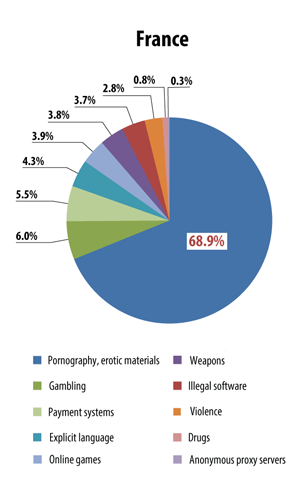
Proportion of visits to sites containing inappropriate content, France, January-May 2014
Spain demonstrated the highest percentage of visits to sites in the Illegal software category (24%) in Western Europe. Moreover, Spain and the UK top the European rating in the Violence category (4.8%).
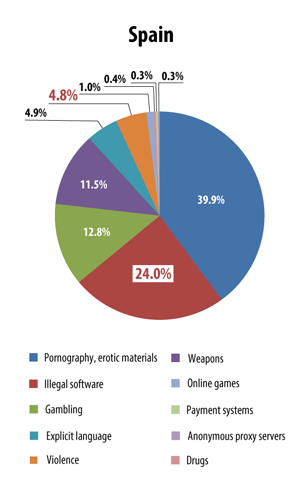
Proportion of visits to sites containing inappropriate content, Spain, January-May 2014
Italy leads the way in the Gambling (15.7%), Weapons (13.7%) and Payment systems (5.1%) categories.
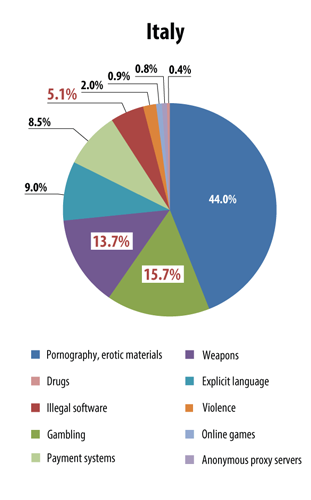
Proportion of visits to sites containing inappropriate content, Italy, January-May 2014
Overall, the statistics from the US don’t differ very much from the European figures, although the percentage of visits to websites in the Violence category (7%) is higher than in western European countries.

Proportion of visits to sites containing inappropriate content, US, January-May 2014
In Mexico, the share of the Violence category (8.6%) is even higher, finishing second in the rating for this country.
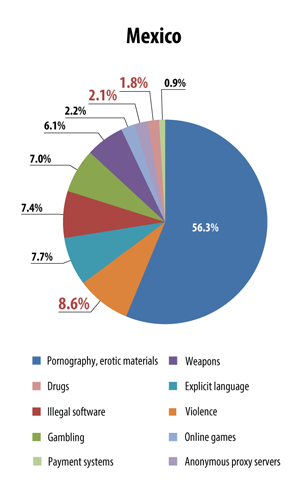
Proportion of visits to sites containing inappropriate content, Mexico, January-May 2014
Among all countries under analysis, Mexico is the leader in the Drugs (2.1%) and Anonymous proxy servers (1.8%) categories.
Forbidden knowledge
Traditionally, the categories that are considered the most undesirable for children have been Pornography, Violence, and Drugs.
Adult images
Pornography is the most obvious of all the unwanted categories of sites and it is most often ticked by parents as forbidden. At the same time, in almost all countries this category usually tops the rating of notifications from the Parental Control module, with other categories much further behind.
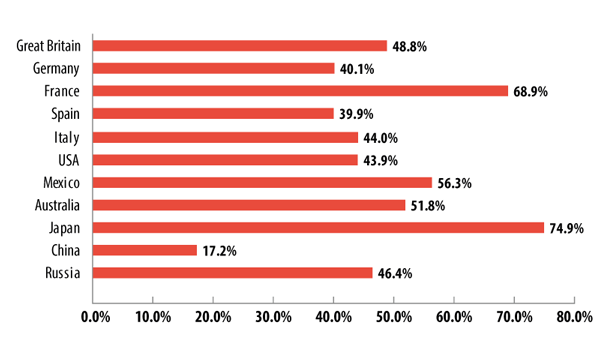
The percentage of visits to sites in the Pornography, erotic materials category
As can be seen in the graph above, the countries with most visits to sites with pornographic and erotic content are Japan and France.
Erotic and pornographic content on the Web is mainly concentrated on specialized sites that warn visitors about their “adult” content. However, images and text of this kind can be seen on dating sites, public forums and on almost any social networking site in one form or another.
Even the most innocent websites may contain a porn banner which has ended up there via an advertising network.
Educational sites and encyclopedias can even contain unwanted content. For example, in Wikipedia pages devoted to different sexual practices are not difficult to find, including particularly lewd or obscene sexual acts.
It is not difficult to protect children from accidental exposure to pornographic content because it is easily recognized by parental control systems.
As for porn banners on public sites, they can be blocked using anti-banner modules that can be installed separately or are included in the antivirus package.
Violence
Yet another category of sites that is obviously undesirable and even dangerous for children is that of Violence. The Web is a place where you can find almost everything, including dismemberment scenes involving humans and animals, descriptions of torture, photos of corpses, advice on how to commit suicide and photographs of executions.
Like pornography, most violence and death-related content is concentrated on specialized web pages designed for those who get their thrills in this way. All these sorts of resources are detected by Parental Control.
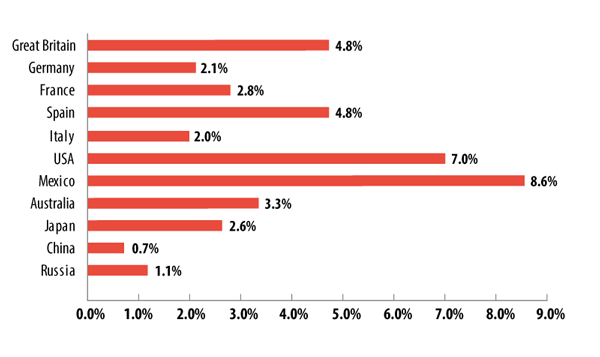
The percentage of visits to sites in the Violence category
The largest proportion of visits to sites in the Violence category occurs in Mexico and the US, and the UK and Spain in Europe.
According to Parental Control statistics, the popularity of sites in this category is relatively low. But we must remember that it is almost impossible to reach these sites accidentally; they have to be sought out deliberately. Therefore, even a low percentage of visits to sites in this category should come as a wake-up call to parents. Fortunately, many sites and web pages that describe how to commit suicide are already blocked by legislation in many countries.
Drugs
Some time ago, drugs were the main concern for experts worried about protecting children on the Internet. Back then it was easy to find lots of methods for preparing drugs, descriptions of how to take them, as well as materials glorifying drug use. This sort of information is very dangerous because some drugs can be made from ingredients that are freely available, while the relevant information on the Internet allows anyone to get high.
Once the authorities became aware of the problem, they started blocking dangerous drug-related information. When this is combined with Parental Control, the chances of finding information online about drugs are minimized. It is important that the appropriate category is ticked by parents inside the module: in this case Parental Control not only categorizes but blocks children’s access to sites with dangerous content.
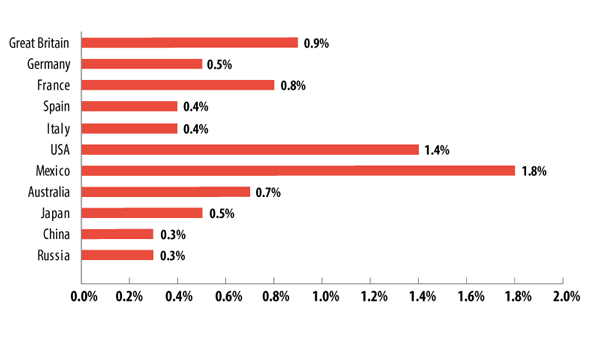
The percentage of visits to sites in the Drugs category
The sites that fall into the Drugs category – like those that come under the Violence category – are most often visited in Mexico and in the US. The UK is third in this respect.
However, not all content can be identified as “Drugs”. For example, the Internet contains images that present drug-taking in a positive light (so-called inspiration pictures).
To some extent, the risk this content poses to children is reduced by the fact that the hosting site bears responsibility for filtering these types of images. The most popular sites restrict access to this kind of content.
Curious coincidences
Statistics based on Parental Control notifications not only highlight differences but also some interesting coincidences.
Information about children’s visits to sites in the 10 selected categories can be affected by the habits and knowledge of adults. For example, illegal software is especially popular in China where this category is well ahead of the others in the rating.

The percentage of visits to sites in the Illegal software category
Although the share of the Illegal software category is much smaller in other countries (only Spain stands out), we strongly recommend activating this category in Parental Control because sites offering illegal software often spread malware as well.
The level of interest in sites belonging to different categories varies from country to country, but there appear to be links between certain categories. The proportion of sites visited in the Violence category from country to country, for instance, is accompanied by similar fluctuations in the Drugs category. This link is observed in all the countries on our list with the exception of Spain and Russia.
Whereas the statistics for these two categories fits into the accepted notion that drugs and violence are related, the second match was quite unexpected: from country to country the link between the level of interest in the Gambling category and that of the Weapons category was almost identical.
The exception, which is clearly seen in the chart above, is Russia. Further analysis showed that the unexpectedly high level of interest in the Weapons category may be due to the interest in Online games in the country.
The dangers of communication
As well as undesirable content, children can encounter other things online that are just as detrimental to their state of mind. Many children today spend more time online than they do outside playing. This plays into the hands of various criminals and generally nasty people. As a rule, children playing outside are under the supervision of adults or are surrounded by friends – things that usually ward off unwanted attention. Bystanders may also notice if someone is showing too much interest in a child or threatens violence. On the Internet, a child can come “face to face” with potential abusers who are usually confident of their anonymity and act more brazenly as a result.
Pedophiles
The Internet makes it possible for pedophiles to target children on social networking sites, forums, chat rooms and other resources that provide direct communication with a potential victim. They act in different ways. Some of them openly declare their intentions, offering a child a variety material benefits in exchange for sexual favors. Others take the time to groom a child, gradually inducing him/her to meet in person when they sexually assault the victim. The first type are easy to identify and neutralize, while the latter are far more dangerous because they don’t reveal their true intentions immediately.
Parental Control protects children from online pedophiles by using, for example, a simple chat detector. If your child receives unpleasant messages, the detector will recognize specific words or phrases and sends a signal to the parents notifying them of a suspicious incoming message. Parents also get notifications about new friends on social networking sites. All this helps to identify a potential pedophile and to take timely measures to block their activity.
Cyber terror
In many countries children and especially adolescents often face cyber bullying. The bullies use all possible channels of communication: social networking sites, forums, chat and instant messengers causing the victim serious mental anguish that can lead to psychological damage or even suicide.
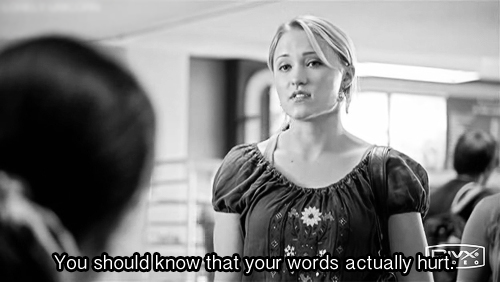
Scene from the film Cyberbully
The bullying may come from acquaintances of the victim (classmates, neighbors, online friends, etc.) or complete strangers. For example, after seeing a photo of the victim online, the bullies can use the anonymity of the Internet to target the victim for fun and even involve other bullies in various online communities.
Bullying can take different forms: insults sent via private messages, publication of provocative material or revealing confidential information. The aims of the bullying can also vary, from teenage pranks and one-upmanship to making the victim commit suicide.
Combating cyber bullying is not so simple from a technical point of view, meaning Parental Control is not so effective. At the same time, children are often unable to cope with the bullies on their own, and they rarely seek help from adults. This can be because of threats made by the bullies or simply because they don’t trust anyone enough to tell them. The child’s relationship with his/her parents therefore plays the most important role when protecting against cyber bullies.
The security formula
Parents need to understand that they are the only ones who can protect their children from the darker corners of the Internet. There aren’t many moms and dads who can sit with their children whenever they are at the computer. That’s why the use of parental control software has become a necessity.
Parental Control is a powerful tool capable of protecting a child against dangerous and unwanted information on the Internet. However, parents should not rely solely on software in every instance. They need to remember they are responsible for the safety of their children and cannot rely entirely on technical safeguards. Educating children about online threats is also very important because the Internet will inevitably play a huge part in their lives.
Do not leave your child to face the vastness of the Internet alone!
A child’s safety on the Internet = control by parents + Parental Control.
For our part, we experts and developers of parental control systems will continue to improve the protection tools and safeguards against cyber threats to provide our children with maximum security on the Internet.
Happy International Children’s Day!
Children online: the security formula
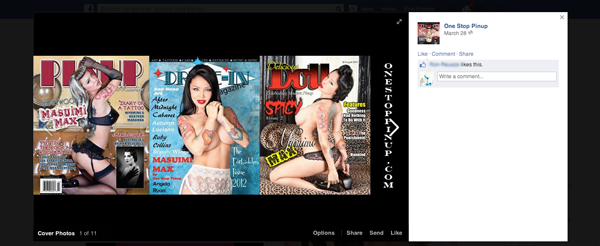
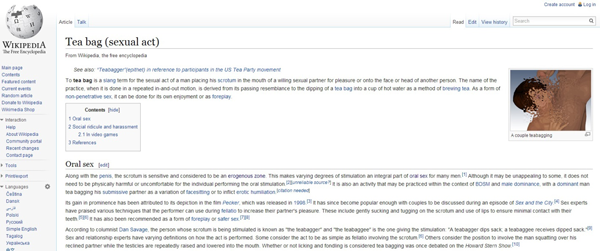
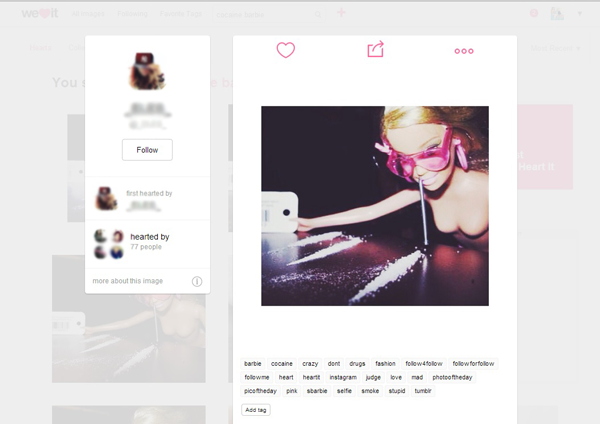
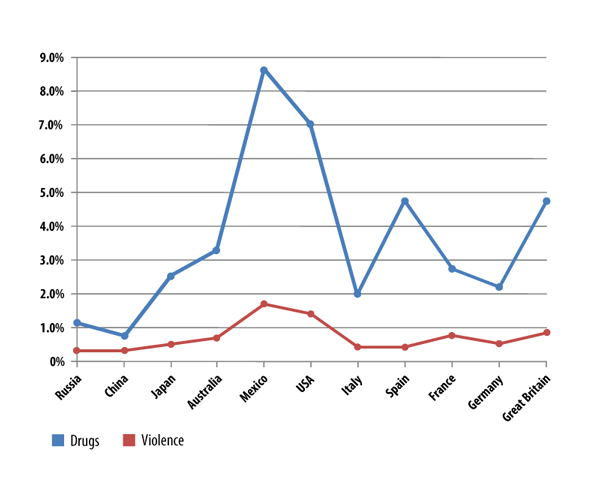


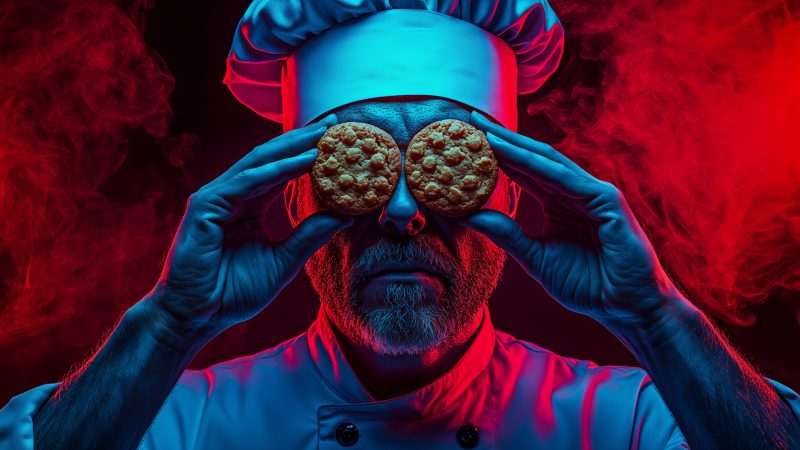


















Joseph McCormick
We need all the help as parents and grandparents to protect our children until they can judge for themselves at the proper time .
Louis Alamina
Thank you for your advice; as concerned parent I appreciate it very much.
Arjun Singh
Need all the help as parents to protect our children until they can judge for themselves at the proper time .